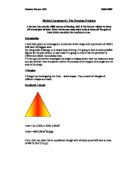All of the results that I have recorded so far all fit into the line on my graph that I have concluded making my graph correct.
As I have found out that a square will always have the biggest area inside the rectangle group I am now going to try and work out what the biggest area of a triangle could be. I am going to work on only isosceles triangle as they are more easy to work out as if I have one bit of information on the base length of a triangle I could work out the length of the other two sides as they are the same.
E.g. if the base of the triangle was 200m long then I could subtract 200 from a thousand leaving me with 800m left and then I could divide 800 by 2 leaving me with 400m for each of the unknown lengths. Using a formula for this could be a lot simpler.
Side=(1000-200) ÷ 2=400
I will need the height of a triangle to be able to work out the area and to find this I will need a formula or some sort of equation looking like this when using 200. This can be used using Pythagoras rule.
H2 = h2 – a2
H2 = 4002 – 1002
H2 = 150000
H = 387.298
0.5x200x387.298 = 38729.8m.
Below are three different types of isosceles triangle.
As the regular square was the biggest in area of the rectangles I put in 333.3 as a triangle as that is the regular isosceles triangle.
Here is a graph from the table above.
You can see that the graph has the same positive trend in it as the first rectangle graph if I would have carried the rectangle graph on it would look identical to this one meaning it would be a parabola (an upward trend to start with then a downward trend in the middle.) Once again the regular shape has the most area. So again I am going to work the areas out at the regular shape triangle around 333, 333.25, 333.3, 333.5, 333.75 and 334.
Once again this table has proved that all the results that I have recorded all fit on the line on the graph that I have produced proving that my results are correct and the regular isosceles triangle is the biggest area of triangles.
As the last of the shapes that I have investigated have all been regular I am now going to just investigate regular shapes as this will be a lot easier as there are so many different combinations that some shapes would be but if there was more time I could investigate further into irregular shapes proving what has the biggest area.
A regular pentagon has five sides meaning that I can divide the pentagon into five isosceles triangles. The top angle of each isosceles triangle will be 720 this is because of 3600 divided by 5 is 720 and from this information given I can work out the other two sides of the isosceles triangle by taking away 720 from 1800 and then dividing it by 2 giving you 540 as each isosceles triangle can be split up into two right angled triangles then you can work out the area of each triangle using trig. As I know each side of the pentagon is going to be 200m as each side of a regular pentagon is equal and it must add up to 1000m. This now means that each right-angled triangles base is going to be 100m.
Using the Sin=O
H
Cos=A
H
Tan=O
A
H=O=100= 137.638
T tan36
This had now worked out the hypotenuse of the right-angled triangle and from this I can now work out the area.
Area=0.5xbasexH=0.5x100x137.638=6881.910m2
6881.910x10=68819.1
All of the results that I have recorded in this have proved that the more sides that a shape has the bigger the are is going to get so to make sure that this prediction is true I am going to prove this with bigger sided regular shapes a hexagon with 6 sides and a heptagon with 7 sides.
To work out the area of the hexagon I am going to use the same method as before which I used on the pentagon.
1000÷6=166.67 this has given the length of each side of the regular hexagon but as the hexagon can be split up into right-angled triangles I will have to divide this answer by two to get 83.34 now I will need to find the angle of each Isosceles triangle which is done like this 360÷6=60
Now I have found out the answer to how big each angle is going to be on the isosceles triangle I am now going to have to find the angle of each right-angled triangle by dividing by two to give me 30. Now I will have to find out the hypotenuse of the right-angled triangles that is done like this.
H=O=83.34=144.338
T tan30
Area=BasexH=0.5x83.34x144.338=6014.065
6014.065x12=72168.784m2
Same working will go for the heptagon.
1000÷7=142.857÷2=71.429
360÷7=51.429÷2=25.714
H=O= 71.429 =148.323
T tan25.714
Area=0.5xBasexH=0.5x71.429x148.323=5297.260
5297.260x14=74161.644m2
As I thought that my predictions were correct I now have proved that as the number of sides of a regular shape increases the area of the shape then increases. Below is the table of the shapes I have researched and hopefully would have proved that my predictions are correct.
Now that I have done the given research I can now work out a formula for the length of each segment of base for the shape given which is when s equals the number of sides of a shape is 1000÷2s=, and the formula for finding the angle of each segment is then 360÷2s=.
Now that I have used this equation and I have proved that it is correct I am going to use it to work out the areas of a regular octagon, nonagon and decagon. And it has been used in the table below.
As you can see the more amount of sides that there are the bigger the area is. And this has occurred on every type of shape that I have investigated so I am now going to research other shapes of a lot larger amount of sides consisting of 20, 50, 100, 200, 500, 1000, 2000, 5000, 10000, 20000, 50000 and 10000.
Here is the graph from the table above.
As you can see from the graphs that I have produced the line starts to straighten as the number of sides increases as I am increasing the sides by large amounts the results are not changing so I am going to see the results from a circle. A circle has an unlimited amount of sides so the formula that I have used will not work on this shape like the others. In order to work out the area of a circle with a circumference of 1000m we need to find the diameter we know that the diameter is twice the radius.
Diametre of a circle= Circumference÷π=318.10÷2=159.155
So the area of a circle is;
πr2=πx159.1552 =79577.472m2
If I place this result upon my graph it is on the same point as the last results I recorded from this I can conclude that a circle has the greatest area when using a similar circumference.






